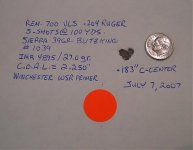H
huntinfool
Guest
It seems every Remington rifle I pick up these days has those pressure pads putting upward pressure on the barrel at the forend. This goes against everything I've ever been told by custom gunsmiths and NONE of my full customs have these. I've always been told a free floated barrel shoots best (except for the ultralights). Are you guys removing the pads and finding out the rifle shoots better or just the opposite?
The rifle I just purchased is the XR-100 Remington and it has the varmint contour and the stock has the pressure pads. I have not shot it and won't do anything until I see how it shoots.
The rifle I just purchased is the XR-100 Remington and it has the varmint contour and the stock has the pressure pads. I have not shot it and won't do anything until I see how it shoots.


